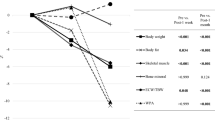Abstract
Background
Although a survival benefit of neoadjuvant treatment for patients with esophageal cancer has been highlighted, the influence of neoadjuvant treatment on the nutritional status of patients with esophageal cancer is not well understood.
Methods
Changes in body composition parameters were assessed in 30 patients who underwent neoadjuvant chemotherapy (NAC) comprising docetaxel, cisplatin, and 5-fluorouracil followed by esophagectomy from August 2009 to April 2013. Body composition was evaluated before and after NAC using multifrequency bioelectrical impedance analysis (InBody 720; Biospace, Tokyo, Japan). Postoperative complications were graded according to the Clavien-Dindo classification.
Results
Twenty-three postoperative events occurred in 16 patients. A decrease in body protein was observed in 13 patients (43.3 %), while skeletal muscle (SM), body cell mass (BCM), and fat-free mass (FFM) declined in 11 patients (36.7 %) during NAC. Changes in these four parameters during chemotherapy significantly differed between patients with postoperative complications and those without: protein, −1.6 ± 0.9 versus +4.4 ± 2.1 kg (P = 0.01); SM, −1.3 ± 1.1 versus +4.7 ± 2.4 kg (P = 0.02); BCM, −2.4 ± 1.6 versus +3.8 ± 2.2 kg (P = 0.03); and FFM, −1.4 ± 1.4 versus +4.3 ± 2.3 kg (P = 0.04).
Conclusions
Changes in body composition parameters are possible predictive markers of postoperative complications after esophagectomy after NAC. Further analysis is needed to clarify whether nutritional intervention improves such parameters and thus contributes to reduced postoperative morbidity.


Similar content being viewed by others
References
Earlam R, Cunha-Melo JR. Oesophageal squamous cell carcinoma: I. A critical review of surgery. Br J Surg. 1980;67:381–90.
Wu PC, Posner MC. The role of surgery in the management of oesophageal cancer. Lancet Oncol. 2003;4:481–8.
Sjoquist KM, Burmeister BH, Smithers BM, et al. Survival after neoadjuvant chemotherapy or chemoradiotherapy for resectable oesophageal carcinoma: an updated meta-analysis. Lancet Oncol. 2011;12:681–92.
Ando N, Kato H, Igaki H, et al. A randomized trial comparing postoperative adjuvant chemotherapy with cisplatin and 5-fluorouracil versus preoperative chemotherapy for localized advanced squamous cell carcinoma of the thoracic esophagus (JCOG9907). Ann Surg Oncol. 2012;19:68–74.
Hirao M, Ando N, Tsujinaka T, et al. Influence of preoperative chemotherapy for advanced thoracic oesophageal squamous cell carcinoma on perioperative complications. Br J Surg. 2011;98:1735–41.
Watanabe M, Nagai Y, Kinoshita K, et al. Induction chemotherapy with docetaxel/cisplatin/5-fluorouracil for patients with node-positive esophageal cancer. Digestion. 2011;83:146–52.
Yoshida N, Watanabe M, Baba Y, et al. Influence of preoperative docetaxel, cisplatin, and 5-fluorouracil on the incidence of complications after esophagectomy for resectable advanced esophageal cancer. Dis Esophagus. 2014;27:374–9.
Jaffrin MY, Morel H. Body fluid volumes measurements by impedance: a review of bioimpedance spectroscopy (BIS) and bioimpedance analysis (BIA) methods. Med Eng Phys. 2008;30:1257–69.
Kim M, Kim H. Accuracy of segmental multi-frequency bioelectrical impedance analysis for assessing whole-body and appendicular fat mass and lean soft tissue mass in frail women aged 75 years and older. Eur J Clin Nutr. 2013;67:395–400.
Kaido T, Mori A, Ogura Y, et al. Pre- and perioperative factors affecting infection after living donor liver transplantation. Nutrition. 2012;28:1104–8.
Sobin LH, Gospodarowicz MK, Wittekind CW. TNM classification of malignant tumours. 7th ed. New York: Wiley-Blackwell; 2009.
Dindo D, Demartines N, Clavien PA. Classification of surgical complications: a new proposal with evaluation in a cohort of 6336 patients and results of a survey. Ann Surg. 2004;240:205–13.
Grotenhuis BA, Wijnhoven BP, Grune F, van Bommel J, Tilanus HW, van Lanschot JJ. Preoperative risk assessment and prevention of complications in patients with esophageal cancer. J Surg Oncol. 2010;101:270–8.
Nozoe T, Kimura Y, Ishida M, Saeki H, Korenaga D, Sugimachi K. Correlation of pre-operative nutritional condition with post-operative complications in surgical treatment for oesophageal carcinoma. Eur J Surg Oncol. 2002;28:396–400.
Ryan AM, Reynolds JV, Healy L, et al. Enteral nutrition enriched with eicosapentaenoic acid (EPA) preserves lean body mass following esophageal cancer surgery: results of a double-blinded randomized controlled trial. Ann Surg. 2009;249:355–63.
Dewys WD, Begg C, Lavin PT, et al. Prognostic effect of weight loss prior to chemotherapy in cancer patients. Eastern Cooperative Oncology Group. Am J Med. 1980;69:491–7.
Han-Geurts IJ, Hop WC, Tran TC, Tilanus HW. Nutritional status as a risk factor in esophageal surgery. Dig Surg. 2006;23:159–63.
Chen Z, Wang Z, Lohman T, et al. Dual-energy X-ray absorptiometry is a valid tool for assessing skeletal muscle mass in older women. J Nutr. 2007;137:2775–80.
Jackson W, Alexander N, Schipper M, Fig L, Feng F, Jolly S. Characterization of changes in total body composition for patients with head and neck cancer undergoing chemoradiotherapy using dual-energy X-ray absorptiometry (DEXA). Head Neck. 2013. doi:10.1002/hed.23461.
Hennessey DB, Burke JP, Ni-Dhonochu T, Shields C, Winter DC, Mealy K. Preoperative hypoalbuminemia is an independent risk factor for the development of surgical site infection following gastrointestinal surgery: a multi-institutional study. Ann Surg. 2010;252:325–9.
Kawaguchi T, Taniguchi E, Itou M, et al. Body cell mass is a useful parameter for assessing malnutrition and severity of disease in non-ascitic cirrhotic patients with hepatocellular carcinoma or esophageal varices. Int J Mol Med. 2008;22:589–94.
Peng PD, van Vledder MG, Tsai S, et al. Sarcopenia negatively impacts short-term outcomes in patients undergoing hepatic resection for colorectal liver metastasis. HPB (Oxford). 2011;13:439–46.
Disclosures
The authors report no financial interests or potential conflicts of interest.
Author information
Authors and Affiliations
Corresponding author
Electronic supplementary material
Below is the link to the electronic supplementary material.
Supplementary Fig. S1
Changes in nutritional parameters during NAC. a Body weight, b body mass index, c fat mass, d total body water, and e mineral content (EPS 1047 kb)
Supplementary Fig. S2
Correlation between body composition changes and the occurrence of postoperative complications. a Decrease in body weight (Δbody weight), b Δbody mass index, c Δfat mass, d Δtotal body water, and e Δmineral (EPS 87.9 kb)
Rights and permissions
About this article
Cite this article
Ida, S., Watanabe, M., Karashima, R. et al. Changes in Body Composition Secondary to Neoadjuvant Chemotherapy for Advanced Esophageal Cancer are Related to the Occurrence of Postoperative Complications After Esophagectomy. Ann Surg Oncol 21, 3675–3679 (2014). https://doi.org/10.1245/s10434-014-3737-z
Received:
Published:
Issue Date:
DOI: https://doi.org/10.1245/s10434-014-3737-z




